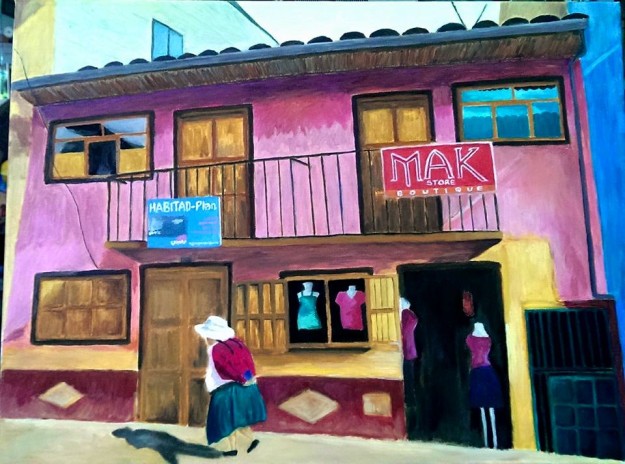Top Experiences
Many people have asked me which is my favourite place on this trip, and believe me it is very difficult to pinpoint one! The emotions, encounters and weather at that place at a particular time or season also affects the entire experience. So how about I give it a go with “Great Experiences” instead? And this time, with photos.
In no particular order:
1. The Galapagos Islands, Ecuador
There may be a bit of bias with this choice since the Galapagos had been my dream islands for years. But many people whom I later met and who had also been there couldn’t get enough of it either, so I really don’t think I’m over-hyping this. Apart from being pampered on a relaxing cruise and visiting pristine islands where animals frolick about in their daily activities oblivious to the snap-happy human visitors, the climate was another surprising factor: not too hot and not too cold in July. The scenery was also more beautiful than I had expected.
It would be a mistake just to use mainland Ecuador as a hop-over point to the Galapagos: Ecuador is a beautiful country with warm & friendly people and relatively good infrastructure. As a visitor, the biggest observation is how family-oriented Ecuadorians are. I did not encounter any difficulty at all travelling solo in Ecuador.

Isla Santa Fe, Galapagos

Galapagos wildlife. From bottom left (clockwise):Galapagos penguin, land iguana, blue-footed boobies, sea lion, giant tortoise
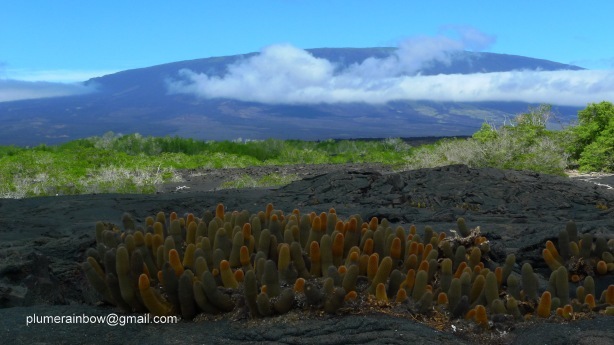
Foreground: tiquila cacti. Background: Volcan la Cumbre. At Punta Espinosa, Isla Fernandina
2. San Pedro de Atacama & around, Chile
The Atacama Desert is one of the driest in the world and is prime spot for star gazing, both for professional astronomers and amateurs. You could see the Desert from the bus on the way from Calama to San Pedro de Atacama (San Pedro). I loved how San Pedro itself does not have paved roads, preserves the older adobe houses made of mud & cactus branch with little roofing and only minimal street lights at night. During the day, the town itself is a base for venturing into the outlying natural wonders and those that I’ve visited include: Valle de la Luna, Valle de Muerte, Piedra del Coyote, the Altiplano lagoons, Salar de Atacama and El Tatio Geyser. At night, just lift up your head and you are treated to more spectacular wonders even with just the naked eye: the cloudless night sky is the perfect canvas for the milky way and the planets of the solar system.
Although San Pedro and the outlying sights are very popular with tourists, the town itself is still very laid-back and a nice place to relax and chill. One simply could not say the same of other popular tourists sites.

Top: Laguna Chaxa Bottom: Salar de Atacama
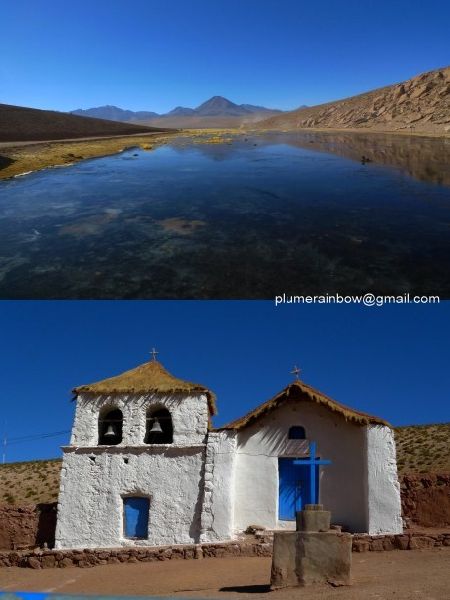
Top: Volcano Putana Bottom: church at Macucha Village
3. Salar de Uyuni & Reserva Fauna Andina Eduardo, Bolivia
This region is one of the most visited places in Bolivia, and with good reason too. I went during dry season and the expanse of the salt flat’s whiteness stretches far beyond the horizon. You would think it is a snow-covered desert, except that if you lick the ground you will know it is not. This region is also rather close to Calama and San Pedro de Atacama of Chile, so there are some similarities in landscape, but there are simply no two identical lagoons, geysers, mountains or salt flats; both regions are rugged and dramatic in their own way. A lot of the sights on the Bolivian side are on higher altitude and are not accessible by paved roads, so travel by land-rovers/jeeps are absolutely necessary. Expect an adventure when in Bolivia; you won’t be disappointed.
Sadly too, the Bolivian side lacks proper management and the environment runs the risk of being overburdened. The social atmosphere of the region in the two countries is also very different and if you have the time to spare, you should still try to visit both. Money should no longer be an issue as you would have expended so much just to get this part of the world that in fact, it makes more sense to visit both. Border crossing by land from Bolivia to Chile and vice versa in this region is possible and can usually be done within half/1 day.
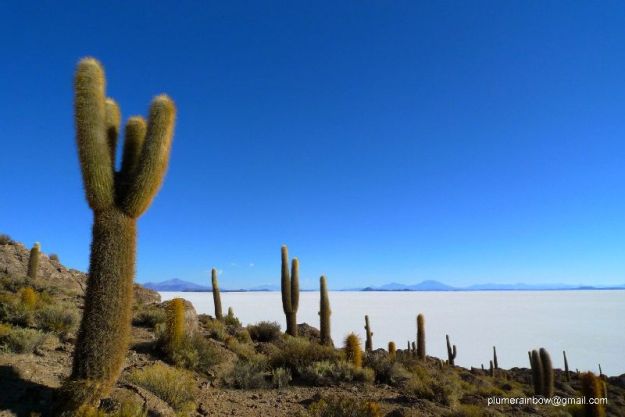
Photo taken on Isla Incahuasi. In the background, the Uyuni salt flats.

Near Laguna Canapa
4.Flying above the Andes in South America
Secondary school level Geography hardly serves any practical purpose in most people’s adult life. But stripped of all the dry facts that one is forced to commit to memory for exams are glimpses into age-old, far-flung, exotic places that are nature’s greatest gifts. Even though Geography text books then hardly came with much photos, learning about the Andean range left a deep imprint in this ex-school girl’s mind.
While it is a lot cheaper to travel in South America by bus (especially if you have the time to spare), I would certainly recommend flying some legs. Conveniently, my round-the-world ticket allowed me to fly quite a few segments in South America, and the domestic flights in some countries are very reasonably-priced. The view over the jagged peaks of the Andes – the spine of South America that stretches from the south in Chile all the way to the north in Columbia & Venezuela – evokes a sense of humbled awe, high-spirited imagination or just simply more wonderful day dreams.

Chilean Andes

Cotopaxi Volcano, Ecuador
5. Scotland, UK
Scotland itself has so much to offer, so justifiably I should have a sub-category of “great experiences”! It is one of the few places on this trip that I would like to visit again, not least because it is closer (more or less 13 hours flight), but also because there are other parts of Scotland that I’ve yet to explore.
On this trip, I would say some of the best moments are:
(1) Walking through glens and along the lochs and simply just enjoying the fresh air & scents from trees & flowers.

Top: Glencoe Lochan Bottom: Glenfinnan
(2) Rocky boat ride to Islet of Staffa – Fingal’s Cave. It was costly to travel to Staffa, but the sight of the hexagonal basalt columns rising vertically out of the emerald waters is worth it. And dolphins somehow never fail to cheer people up even in bad weather. Would have loved to spend more time on the islet if the weather had permitted. Not the season for puffins-sighting, but was already very contented with the visit.

Walking on islet of Staffa

Hexagonal basalt columns rising out of emerald waters to form this Fingal's Cave.
(3) Driving around & exploring Isle of Skye. Skye is rated by National Geographic as one of the best islands in the world for sustainable tourism. Do not expect resorts a la Banyan Tree style – this does not Skye maketh. Instead, look forward to rugged dramatic natural beauty.
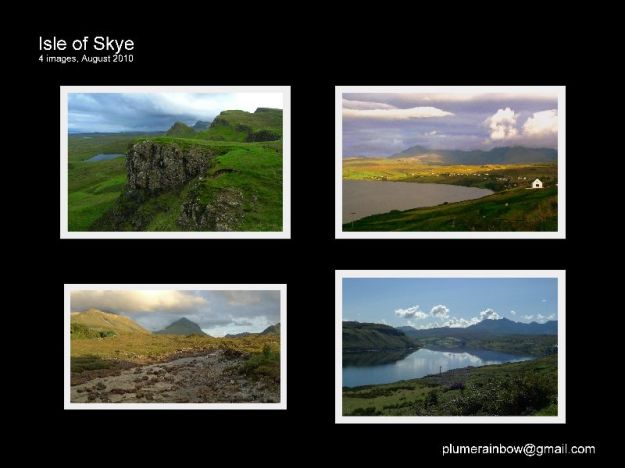
and last but not least,
(4) Chatting with friendly down-to-earth Scots!

Thistle, national flower of Scotland
Of course, this list of “Great Experiences” is non-exhaustive. The list of wonderful places that I have been to on this 4-month trip goes on, including the Great Ocean Road in Australia, Easter Island in the Pacific Ocean, Lake Titicaca in both Peru & Bolivia, the great Machu Picchu as well as all the people I’ve met who made up the entire experience.
Till the next trip. Right now, my heart is warm & contented.
May I wish everyone of you find and pursue your dream adventures. Happy travels!

